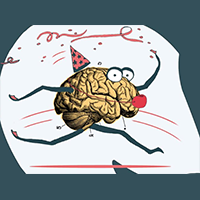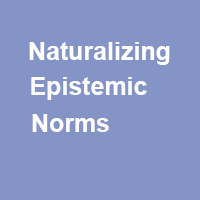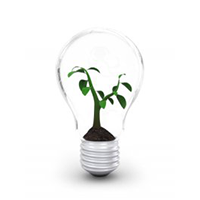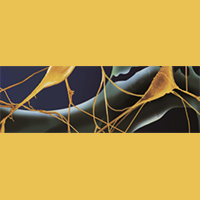FOCUS
Daydreaming, a game to explore the secrets of thinking
Human thought is as rich as it is mysterious. It can help you dive into a
novel for hours, or wander over full paragraphs that you read without a clue to
their meaning, or even about the very fact that your mind has now gone somewhere
else. Literature can perfectly describe its characters’ train of thoughts, but, as far as
science is concerned, no one really understands how thinking works, and what
facilitates deep focus rather than vivid daydreams. Indeed, how can subjective
mental states be studied using objective scientific tools?
Mikaël Bastian (PhD student) and Jérôme Sackur (researcher) from Laboratoire de Sciences Cognitives et Psycholinguistique (LSCP) with the collaboration of Vincent Adam (UCL Londres)
and Sébastien Lerique (EHESS and Centre Marc Bloch, Berlin) tried to address precisely these issues with the help of
modern technology. Inspired by great scientific data-gathering games such as Foldit
or the Great Brain Experiment, and adding laboratory tools such as standardized
questionnaires and “experience sampling”, they managed to develop an android app
for smartphones: Daydreaming.
 Could you please tell us a little about yourselves?
Could you please tell us a little about yourselves?
We are part of a four-person French research team composed of Mikaël Bastian (ENS), Vincent Adam (UCL, London), Sébastien Lerique (EHESS and Centre Marc Bloch, Berlin) and Jérôme Sackur (ENS). The project is part of Mikaël Bastian's PhD (supervised by Jérôme Sackur) which focuses on concentration and distraction. During their freetime, Vincent Adam and Sébastien Lerique have done the painstaking job of working on the technical side of the application: development, data gathering, storage, and result analysis. The team has also hired a designer, Gislain Delaire, to help come up with an original look for the application. This hire was made possible by financial support from the Sciences en Poche project at the Insitut des Systèmes Complexes, coordinated by David Chavalarias.
From left to right: M. Bastian, V. Adam, J. Sackur, S. lerique
Daydreaming is a mobile app for Android products. Could you tell us a little about Daydreaming?
 For the user, Daydreaming is first and foremost a "quanitifed self" tool. From time to time, the user receives a notification that then requires them to respond to a few questions about their current state of concentration. On top of that, during the first few days after the initial download, the user has to respond to questions about their personality, and then every day thereafter, to a series of questions about the quality of their sleep and the kinds of activities they've done during the day. The idea is to look at the overall picture these data provide about your habits and learn more about yourself.
For the user, Daydreaming is first and foremost a "quanitifed self" tool. From time to time, the user receives a notification that then requires them to respond to a few questions about their current state of concentration. On top of that, during the first few days after the initial download, the user has to respond to questions about their personality, and then every day thereafter, to a series of questions about the quality of their sleep and the kinds of activities they've done during the day. The idea is to look at the overall picture these data provide about your habits and learn more about yourself.
But that's not all. Daydreaming tries to reveal things about the way people think that they aren't necessarily aware of. We tell ourselves a lot about ourselves and some of the things we tell ourselves aren't true. For example, 75% of people think they daydream more than other people, which indicates that in general, we tend to underestimate our ability to concentrate.
 In order to get an idea of our real thought processes, the application uses what we call "experience sampling". If you're asked about your concentration about ten times a day every day over a few days, without being able to anticipate the timing of the questions, we can get a good idea if you tend to be distracted or not. This method has been used quite a lot and has provided surprising results: people tend not to realize that what they think about themselves is incredibly biased by a few, very salient moments. Of course, a large amount of data is required in order for the whole thing to make any sense. Results are therefore only available after 30 days of participation and users are encouraged to continue using the app after that.
In order to get an idea of our real thought processes, the application uses what we call "experience sampling". If you're asked about your concentration about ten times a day every day over a few days, without being able to anticipate the timing of the questions, we can get a good idea if you tend to be distracted or not. This method has been used quite a lot and has provided surprising results: people tend not to realize that what they think about themselves is incredibly biased by a few, very salient moments. Of course, a large amount of data is required in order for the whole thing to make any sense. Results are therefore only available after 30 days of participation and users are encouraged to continue using the app after that.
It's important to remember that the goal for us researchers is to gather results within the framework of our research project. These 30 days correspond to the length of our experiment and the experience sampling also helps us understand the situation the users are in when using the app. We hope that this will allow us to identify mental factors (e.g., fatigue) as well as environmental factors (e.g., time of day) that may have an effect on the way we think. This app gives us a unique opportunity to study these factors which would be impossible to obtain using traditional research methods.
How did this project come about? How did you work on developing this app?
This project was born from the desire to meet a technical challenge: how can we develop a scientific mobile application that exploits the new advantages of smartphones (different kinds of measurement, users, integration into daily life, longitudinal studies) while keeping within the framework of a scientific project whose needs correspond exactly to these advantages. Vincent and Sébastien met the technical challenge and Mikaël and Jérôme handled the scientific questions that this application attempts to tackle. This project was also developed with the conviction that the scientists involved had to gain the necessary skills to realize it, instead of outsourcing them. With this goal in mind, we have made the app's code available, to lower the initial investment for anyone who would like to start a similar project, keeping in mind the sometimes prohibitive technical costs that can be associated with such work.
What are the project's goals?
 The goal is to answer a number of scientific questions that have yet to be solved. We say a lot about the advantages of regular physical activity, meditation, as well as on the negative effects of video games on our concentration, but in actuality we have very little data. And what about playing music, or chess: do these activities have any impact? In the same vein, other constraints relating to physical space and time (day of the week, location, etc.) could have yet underestimated effects. We also still know very little about attentional cycles: what happens if a user is probed 10 minutes after an initial probe? 2 hours after? A last example, but we really have many more questions, is there a quantifiable consequence to reflecting about oneself every day, say while using the application for a month?
The goal is to answer a number of scientific questions that have yet to be solved. We say a lot about the advantages of regular physical activity, meditation, as well as on the negative effects of video games on our concentration, but in actuality we have very little data. And what about playing music, or chess: do these activities have any impact? In the same vein, other constraints relating to physical space and time (day of the week, location, etc.) could have yet underestimated effects. We also still know very little about attentional cycles: what happens if a user is probed 10 minutes after an initial probe? 2 hours after? A last example, but we really have many more questions, is there a quantifiable consequence to reflecting about oneself every day, say while using the application for a month?
Daydreaming was developed with support from "Science en Poche", a project funded by the City of Paris. Could you tell us about "Science en Poche"? How did this collaboration develop?
 The "Science en Poche" project is very tied to Daydreaming. It began with a collaboration between the application's developers and David Chavalarias, the director of the Institut des Systèmes Complexes, which focused on a shared observation: the competences required for the development of scientific projects which use web and phone technologies are rarely attested in the academic world. A consequence of this is, for laboratories who can handle the financial burden associated with such projects, the outsourcing of these skills to external companies and a lack of long-term vision. In order to promote the use of such tools by the scientific community, "Science en Poche" attempts to create and share tools, methods, and feedback on the develpment of such projects. Maziyar Panahi, an engineer, was hired to help with this part of the project. To start with, a few example projects are being developed. Daydreaming is one of these example projects. Winnobel, a game which focuses on studying the pressure to publish articles in the scientific world is another example. Thus, in the long-term, the goal will be to create and support a community of users involved in participative research projects which use mobile-based tools.
The "Science en Poche" project is very tied to Daydreaming. It began with a collaboration between the application's developers and David Chavalarias, the director of the Institut des Systèmes Complexes, which focused on a shared observation: the competences required for the development of scientific projects which use web and phone technologies are rarely attested in the academic world. A consequence of this is, for laboratories who can handle the financial burden associated with such projects, the outsourcing of these skills to external companies and a lack of long-term vision. In order to promote the use of such tools by the scientific community, "Science en Poche" attempts to create and share tools, methods, and feedback on the develpment of such projects. Maziyar Panahi, an engineer, was hired to help with this part of the project. To start with, a few example projects are being developed. Daydreaming is one of these example projects. Winnobel, a game which focuses on studying the pressure to publish articles in the scientific world is another example. Thus, in the long-term, the goal will be to create and support a community of users involved in participative research projects which use mobile-based tools.
How many participants do you already have ?
The app came out a month ago. There are already about 200 downloads and about 50 motivated users who are using the application every day.
The experience lasts a month. Thirty users have already finished the experiment, and we have thus collected our first data.
And what about you? Do you know what kind of daydreamer you are?
We started beta-testing the application a couple of months ago with friends and colleagues and naturally couldn't resist the temptation to use it ourselves. Mikaël, for example, relized that he is concentrated over 70% of the time and that he has a very verbal and auditory profile when he's concentrated, but that he tends towards a more visual one when he starts daydreaming.
Daydreaming Experiment App (Android): http://bit.ly/1x8u21a
More information on the website: http://daydreaming-the-app.net
Twitter: @daydreaming_app
Read more about Science en Poche
Grants
Sid Kouider (LSCP) has obtained an ERC consolidator grant for the project METAWARE (Behavioral and neural determinants of metacognition and self-awareness in human adults and infants)
Abstract:
Understanding the psychological and neurobiological determinants of consciousness is fundamental. Yet, the main trend
focusing on how the front of the brain (prefrontal cortex) interacts with the back (sensory cortex) for accessing perceptual
contents limits our understanding of the information coding schemas underlying consciousness. Here, we explore these
informational properties in adults and infants from 3 novel perspectives: sleep, self-consciousness and metacognition. First,
we will study unconscious processes in the full absence of consciousness, including self-consciousness and metacognition,
by focusing on the sleeping brain’s ability to process and learn information from its environment. While most studies on
subliminal perception measured unconscious processes intermixed with conscious ones, studying their impact in the
sleeping brain will provide new insights on a broader and more natural type of unconscious. Secondly, we will explore the
fundamental issue of whether multiple agents can share information and each other’s conscious access mechanisms,
without being aware of it. Using a novel approach called the “Reversed Perspective Paradigm”, we will study if access to
conscious content can be determined by another agent’s actions and sensory processing while the agent is lured to believe
she owns these access mechanisms. We aim at challenging the long-held conviction that consciousness is a paradigm of
privacy, by breaking it using virtual reality and objective methods from psychology. Finally, we will attempt to answer the two
fundamental issues of whether infants have a capacity for metacognition (do they know they know) and whether they
experience self-consciousness (do they feel themselves as a unitary entity). Examining these self-reflection mechanisms,
through behavioural and EEG techniques, will address the issue of whether humans in the initial state have a primitive self,
or are actually unconscious about their own person.
Two postdocs of Laboratoire de Sciences Cognitives et Psycholinguistique obtained a European Marie Curie grant
Christina Bergman for the project VIOLA (Variability's Influence on Language Acquisition).
Abstract:
How is early language development affected by the number of speakers infants are exposed to in their daily lives? Some
infants spend most of their waking time with only one person, while others hear many different speakers. These children
receive quite different input. Even if the very same words are spoken, these words are pronounced very differently when not
one but multiple people spoke them. Laboratory studies point to a significant effect of such variability in the context of a short
experiment: When infants hear multiple speakers, their ability to recognize the same word is hampered, whereas learning
sounds and words improves. It remains an open question whether long-term exposure to multiple speakers in daily life helps
or hinders language acquisition, as current theories lead to opposing predictions. This project combines experimental
approaches with computational modeling. It will shed unprecedented light on how speaker variability in daily life affects
language development, a question that has substantial implications for theories of language acquisition and for current
diagnostic practices.
Sho Tsuji for the project SCIL (The role of social cues for infant word learning).
Abstract:
Infants start knowing the meaning of some words by 6 months of age and by age two they know hundreds. The mechanisms
behind the word learning processes subtending these feats are still poorly understood. Current accounts of infants’ word
learning differ about the degree to which word learning is purely a product of increasingly sophisticated perceptual
associations, versus a process in which associative learning is implicated, but the main engine of development is
fundamentally social and timed by the infant’s grasp of the referential intentions of others when using language. The present
project will explore the mechanisms behind word learning (1) by identifying the elements that lead to a word learning
advantage in a social situation, (2) by assessing whether infants infer intention from social cues, or whether the latter merely
refocus attention, and (3) by testing how long-term word learning is modulated by social cues in naturalistic situations. By
assessing both infants (aged 6-10 months) and toddlers (aged 12-16 months), I will determine whether the mechanisms for
word learning change with age. I will be able to characterize the role of social cues in young infants’ and toddlers' word
learning for the first time by leveraging the cutting-edge technologies of gaze-contingent eye-tracking and infant-friendly
automated toys.
Christina will continue working on her project at the LSCP, in collaboration with Alex Cristia. Sho, on the other hand, will head to the University of Pennsylvania to work with Daniel Swingley, before returning to the LSCP to rejoin Alex Cristia's team.
SOME RECENT PUBLICATIONS
Ramus, F. (2014). Should there really be a “Dyslexia debate”?. Brain, 137, 3371-3374.
Roux, P., Passerieux, C., & Ramus, F. (2015). An eyetracking investigation of intentional motion perception in schizophrenia. Journal of Psychiatry and Neuroscience, 40(2), 118-125.
Philippe Schlenker, Emmanuel Chemla, Kate Arnold, Alban Lemasson, Karim Ouattara, Sumir Keenan, Claudia Stephan, Robin Ryder, Klaus Zuberbühler. Monkey semantics: two ‘dialects’ of Campbell’s monkey alarm calls. Linguistics and Philosophy. December 2014, Volume 37, Issue 6, pp 439-501
Abstract:
We develop a formal semantic analysis of the alarm calls used by Campbell’s monkeys in the Tai forest (Ivory Coast) and on Tiwai island (Sierra Leone)—two sites that differ in the main predators that the monkeys are exposed to (eagles on Tiwai vs. eagles and leopards in Tai). Building on data discussed in Ouattara et al. (PLoS ONE 4(11):e7808, 2009a; PNAS 106(51): 22026–22031, 2009b and Arnold et al. (Population differences in wild Campbell’s monkeys alarm call use, 2013), we argue that on both sites alarm calls include the roots krak and hok, which can optionally be affixed with -oo, a kind of attenuating suffix; in addition, sentences can start with boom boom, which indicates that the context is not one of predation. In line with Arnold et al., we show that the meaning of the roots is not quite the same in Tai and on Tiwai: krak often functions as a leopard alarm call in Tai, but as a general alarm call on Tiwai. We develop models based on a compositional semantics in which concatenation is interpreted as conjunction, roots have lexical meanings, -oo is an attenuating suffix, and an all-purpose alarm parameter is raised with each individual call. The first model accounts for the difference between Tai and Tiwai by way of different lexical entries for krak. The second model gives the same underspecified entry to krak in both locations (= general alarm call), but it makes use of a competition mechanism akin to scalar implicatures. In Tai, strengthening yields a meaning equivalent to non-aerial dangerous predator and turns out to single out leopards. On Tiwai, strengthening yields a nearly contradictory meaning due to the absence of ground predators, and only the unstrengthened meaning is used.
CALENDAR

March 2, 2015
Forum des Sciences Cognitives
Read more...

March 30-31, 2015
3rd Sociophysics workshop “From opinion dynamics to voting, conflict and terrorism”
Read more...

April 1st, 2015
Adrian Cussins (National University of Colombia): "Hot, Wild and Thoughtful"
Read more...

April 3, 2015
Olivier Massin: "Colours as dependent stuffs"
Read more...

April 7, 2015
Elena Pasquinelli (IJN): "The teacher's brain; what we know, what we think we know, what we don't know"
Read more...

April 8, 2015
Markus Kneer (IJN): "Why Semantic Relativists Might Have Overplayed their Hand"
Read more...

April 9, 2015
Daniela Tagliafico (FMSH, IJN): "The Normativity of the Background: A Contextualist Account of Social Facts"
Read more...

April 10, 2015
Colloqium IJN - Jonathan Phillips (Harvard University): "The psychological representation of modality"
Read more...

April 14, 2015
Colloquium du DEC - Michel Raymond
Read more...

April 14, 2015
La conscience de soi dans tous ses états: corps, action, perception
Read more...

April 20, 2015
Claire Petitmengin (Institut Mines-Télécom): "Researching the microdynamics of lived experience"
Read more...

21 avril 2015
Thomas Constant (CNAM): "Games for better decision-making"
Read more...

22 avril 2015
Tristan Thommen (IJN): "Response-dependence and the semantics of slurs"
Read more...
DEC calendar: cognition.ens.fr
DEC Colloquium: http://www.cognition.ens.fr/ColloquiumAgendaENG.html
Subscribe to the newsletter
Unsubscribe from the newsletter
